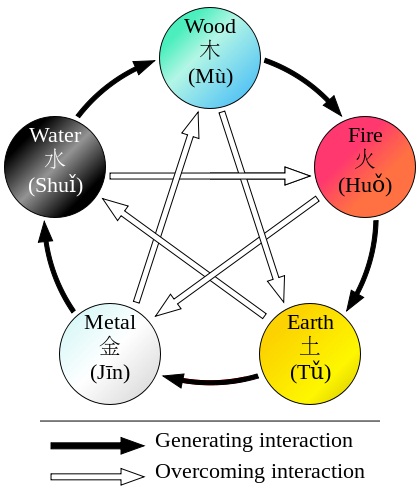 It is clear that each element is extremely powerful on its own, yet their true power comes from the interaction between elements so that the world we live in remains in perfect balance just like the body of an athlete. Rather than use the traditional elements of western cultures to discuss these ideas we will be turning to the eastern idea of Wu Xing. Wu Xing is often referred to as the five elements but is more correctly interpreted as the five phases or processes. The elements or phases used are wood, fire, earth, metal, and water and each often refers to a typical state within nature. Then 2 cycles are used to describe their interactions with one another. The first step in program design is seeing how each phase refers to a different season.
It is clear that each element is extremely powerful on its own, yet their true power comes from the interaction between elements so that the world we live in remains in perfect balance just like the body of an athlete. Rather than use the traditional elements of western cultures to discuss these ideas we will be turning to the eastern idea of Wu Xing. Wu Xing is often referred to as the five elements but is more correctly interpreted as the five phases or processes. The elements or phases used are wood, fire, earth, metal, and water and each often refers to a typical state within nature. Then 2 cycles are used to describe their interactions with one another. The first step in program design is seeing how each phase refers to a different season.
- Wood coincides with the season of spring where nature goes through a period of growth and vitality.
- Fire represents the season of summer where nature swells after reaching full bloom and it is full of energy.
- Metal refers to autumn and the season of harvesting and collecting from nature.
- Water is the period of winter when nature retreats and enters a still hibernating state.
- Earth doesn’t designate any single season but rather the transitional phases between each of the major seasons.
In the training of humans these seasons most closely identify with the ideas of periodization.
- In periodization athletes go through a base period (spring) where they build themselves up and grow to become stronger.
- After achieving a solid base, training is ramped up to become more sport specific and intense to achieve peak potential (summer).
- Once potential is reached the fruits of labor are harvested during the competitive season (autumn) before entering the off-season (winter), a period of retreat and recovery from heavy training.
Upon seeing how each phase relates to basic program design one can then look at the interaction of each element within a phase. The cycles of Wu Xing that are constantly occurring are known as the generating cycle and the overcoming cycle. In the generating cycle the phases are in the following order.
- Wood feeds Fire
- Fire creates ash (Earth)
- Earth produces Metal
- Metal enriches Water through the minerals produced
- Water nourishes Wood and begins the cycle again.
In the overcoming cycle the phases are shown in the following order.
- Wood parts Earth
- Earth blocks or dams Water
- Water extinguishes Fire
- Fire melts Metal
- Metal chops wood and begins the cycle again.
If one looks at how each element relates to characteristics of training and competition they can have a better understanding of how to create a more complete and evolving program for athletic performance. In the generating cycle of athletic performance we can see the following relationships.
- Water is needed to stay hydrated and maintain ample blood volumes. Blood is needed to transport oxygen (air) through the body.
- Oxygen is needed by the muscles to catalyze aerobic reactions to allow the muscles (earth) to contract.
- Muscles attach to strong bones and contract to create movement which in turn creates heat (fire).
- Movement warms the core body temperature which creates sweat (water) in order to cool the body. This causes the body to become thirsty and the athlete to drink more water to replace what is lost.
When looking at the overcoming cycle one can see just how quickly a lack of balance among the elements and their interactions causes a breakdown in the body’s systems.
- Passion (fire) becomes overwhelming and an athlete becomes completely absorbed in nothing but training. This overrides intellect (air) about proper training principles.
- Without intellect in the equation the aspects of recovery (water) are ignored.
- When recovery is ignored the muscles (earth) become overworked and begin to break down and lose strength.
- Without a solid foundation of strong muscles the body begins to breakdown and the fires of passion are extinguished by force.
While the above are simply examples and may not appear to fit together as well as the cycles of Wu Xing it still gives an excellent example of how the different body systems work in conjunction with one another. Using the characteristics of each element individually and then using these principles together provides a coach with a potent tool set to create a program that will maximize performance while minimizing setbacks along the way.



